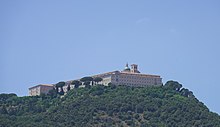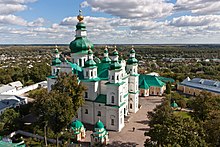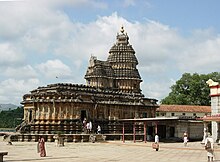Monastery
This article needs additional citations for verification. (September 2023) |
In English usage, the term monastery is generally used to denote the buildings of a community of monks. In modern usage, convent tends to be applied only to institutions of female monastics (nuns), particularly communities of teaching or nursing religious sisters. Historically, a convent denoted a house of friars (reflecting the Latin), now more commonly called a friary. Various religions may apply these terms in more specific ways.
Etymology
The word monastery comes from the
In England, the word monastery was also applied to the habitation of a
Terms
The term monastery is used generically to refer to any of a number of types of religious community. In the
A Christian monastery may be an
The great communal life of a Christian monastery is called
In
.Monastic life

In most religions, life inside monasteries is governed by community rules that stipulate the gender of the inhabitants and require them to remain celibate and own little or no personal property. The degree to which life inside a particular monastery is socially separate from the surrounding populace can also vary widely; some religious traditions mandate isolation for purposes of contemplation removed from the everyday world, in which case members of the monastic community may spend most of their time isolated even from each other. Others focus on interacting with the local communities to provide services, such as teaching, medical care, or evangelism. Some monastic communities are only occupied seasonally, depending both on the traditions involved and the local climate, and people may be part of a monastic community for periods ranging from a few days at a time to almost an entire lifetime.[citation needed]
Life within the walls of a monastery may be supported in several ways: by manufacturing and selling goods, often
Buddhism


Buddhist monasteries, known as
These early fixed vassa retreats took place in pavilions and parks that wealthy supporters had donated to the sangha. Over the years, the custom of staying on property held in common by the sangha as a whole during the vassa retreat evolved into cenobitic monasticism, in which monks and nuns resided year-round in monasteries.
In
Whereas early monasteries are considered[
Forest monasteries – most commonly found in the
Tibetan Buddhist monasteries or gompas are sometimes known as lamaseries, with their monks sometimes (mistakenly) known as lamas. Helena Blavatsky's Theosophical Society named its initial New York City meeting-place "the Lamasery".[3]
Famous Buddhist monasteries include:
- Donglin Temple, Jiangxi, China
- Jetavana, Shravasti (India)
- Nalanda, India
- Shaolin Monastery, China
- Tengboche, Nepal
For a further list of Buddhist monasteries see list of Buddhist temples.
Trends
Buddhist monasteries include some of the largest in the world. Drepung Monastery in Tibet housed around 10,000 monks prior to the Chinese invasion[4][5] in 1950–1951. As of 2020[update] the relocated monastery in India houses around 8,000.[citation needed]
Christianity

According to tradition, Christian monasticism began in Egypt with Anthony the Great. Originally, all Christian monks were hermits seldom encountering other people.[citation needed]
A transitional form of monasticism was later created by Ammonas in which "solitary" monks lived close enough to one another to offer mutual support as well as gathering together on Sundays for common services.[citation needed]
It was
The idea caught on, and other places followed:
- Upon his return from the Council of Serdica, Athanasius of Alexandria established the first Christian monastery in Europe circa 344 near modern-day Chirpan in Bulgaria.[7]
- Persia, Armenia, Georgia and even India and China.[citation needed]
- Mar Saba organized the monks of the Judaean Desert in a monastery close to Bethlehem (483), and this is considered the mother of all monasteries of Eastern Orthodoxy.[citation needed]
- Order of Saint Benedict in particular.[citation needed]
- The Carthusians were founded by Bruno of Cologne at the Grande Chartreuse, from which the religious Order takes its name, in the eleventh century as an eremitical community, and remains the motherhouse of the Order.[citation needed]
- Jerome and Paula of Rome decided to go and live a hermit's life in Bethlehem and founded several monasteries in the Holy Land. This way of life inspired the foundation of the Hieronymites in Spain and Portugal. The Monastery of Santa María del Parral in Segovia is the motherhouse of the Order.[citation needed]
Western Medieval Europe

The life of prayer and communal living was one of rigorous schedules and self-sacrifice. Prayer was their work, and the Office prayers took up much of a monk's waking hours –
The main meal of the day took place around noon, often taken at a
Monasteries were important contributors to the surrounding community. They were centres of intellectual progression and education. They welcomed aspiring priests to come and study and learn, allowing them even to challenge doctrine in dialogue with superiors. The earliest forms of
A Warming House is a common part of a
Catholic

A number of distinct
- Camaldolese monks
- Rule of St. Augustine;
- Carmelite hermits and Carmelite nuns (from the Ancient Observance and Discalced branch);
- Trappistreform);
- Monks and Sisters of Bethlehem
- Order of Minims, founded by Francis of Paola
- Order of Saint Benedict, known as the Benedictine monks and nuns, founded by Benedict of Nursia with Scholastica, stresses manual labour in self-subsistent monasteries. See also: Cluniac Reforms;
- Order of Saint Claire, best known as the Poor Clares (of all the observances);
- Order of Saint Jerome, inspired by Jerome and Paula of Rome, known as the Hieronymite monks and nuns;
- Order of Saint Paul the First Hermit, known as the Pauline Fathers;
- Order of the Annunciation of the Blessed Virgin Mary, also known as Sisters of the Annunciation or Annociades, founded by Joan of France;
- Order of the Carthusians, a hermitical religious order founded by Bruno of Cologne;
- Order of the Immaculate Conception, also known as the Conceptionists, founded by Beatrice of Silva;
- Order of the Most Holy Annunciation, also known as Turchine Nuns or Blue Nuns, founded by Maria Vittoria De Fornari Strata;
- Order of the Most Holy Savior, known as Bridgettine nuns and monks, founded by Bridget of Sweden;
- Order of the Visitation of Holy Mary, known as the Visitandine nuns, founded by Francis de Sales and Jane Frances de Chantal;
- Passionists
- Premonstratensian canons("The White Canons")
- Tironensian monks("The Grey Monks")
- Valliscaulian monks
While in English most
Eastern Orthodox

In the
Monasteries vary from the very large to the very small. There are three types of monastic houses in the Eastern Orthodox Church:
- A daily office, work and meals are all done in common.
- A feast days. Thus, skete life has elements of both solitude and community, and for this reason is called the "middle way".
- A hermit is a monk who practises asceticism but lives in solitude rather than in a monastic community.
One of the great centres of Eastern Orthodox monasticism is Mount Athos in Greece, which, like Vatican City, is self-governing. It is located on an isolated peninsula approximately 20 miles (32 km) long and 5 miles (8.0 km) wide, and is administered by the heads of the 20 monasteries. Today the population of the Holy Mountain is around 2,200 men only and can only be visited by men with special permission granted by both the Greek government and the government of the Holy Mountain itself.[citation needed]
Oriental Orthodox

The
The monasteries of St. Macarius (Deir Abu Makaria) and St. Anthony (Deir Mar Antonios) are the oldest monasteries in the world and under the patronage of the Patriarch of the Coptic Orthodox Church.[citation needed]
Others
The last years of the 18th century marked in the Christian Church the beginnings of growth of monasticism among
In the 19th-century monasticism was revived in the
Trends
There is a growing Christian neo-monasticism, particularly among evangelical Christians.[8]
Hinduism
Advaita Vedanta

From the times of the

- Emar Matha at Puri
- Sriranga Narayana Jeeyar Mutt at Srirangam
- Tirumala Pedda Jeeyangar Mutt at Tirupati
Later on, other famous Sri Vaishnava theologians and religious heads established various important mathas such as
- Vanamamalai Mutt
- Parakala Mutt
- Ahobila Mutt

Nimbarka Sampradaya of Nimbarkacharya is popular in North, West and East India and has several important Mathas.
- Nimbarakacharya Peeth at Salemabad, Rajasthan
- Kathia Baba ka Sthaan at Vrindavan
- Ukhra Mahanta Asthal at Ukhra in West Bengal
- Howrah Nimbarka Ashram at Howrah
Dvaita Vedanta
- Gaud SaraswatMath
- Kashi Math at Varanasi, Uttar Pradesh
- Gokarna Math at Canacona, Goa[citation needed]
Jainism
Jainism, founded by Mahavira c. 570 BC, had its own monasteries since 5th century BC.[citation needed]
Sufism
Islam discourages monasticism, which is referred to in the Quran as "an invention".[9][10] However, the term "Sufi" is applied to Muslim mystics who, as a means of achieving union with Allah, adopted ascetic practices including wearing a garment made of coarse wool called "sf".[11] The term "Sufism" comes from "sf" meaning the person, who wears "sf".[12] But in the course of time, Sufi has come to designate all Muslim believers in mystic union.[13]
See also
- Dissolution of the monasteries
- Ecovillage
- Intentional community
- Khanqah
- Krishnapura matha
- List of abbeys and priories
- List of Buddhist temples
- List of monasteries of the Ukrainian Orthodox Church (Moscow Patriarchate)
- Monasticism
- Mount Athos
- New Monasticism
- Pilgrimage
- Religious order
- Rota (architecture)
- Shivalli
- Taoism
- Thomas Merton
- Vihara
- Wudangshan
- Zawiya
References
- ^ "Online Etymology Dictionary".
- S2CID 161518883.
- ^ Crowley, John (February 2013). "Madame and the Masters: Blavatsky's cosmic soap opera". Harper's. p. 84.
- ^ "Tibet in Louisville". Spiritual Travels. Lori. Archived from the original on 2017-11-07. Retrieved 2013-02-11.
- ^ Macartney, Jne (March 12, 2008). "Monks under siege in monasteries as protest ends in a hail of gunfire". The Sunday Times.
- ^ Dunn, Marilyn. The Emergence of Monasticism: From the Desert Fathers to the Early Middle Ages. Malden, Mass.: Blackwell Publishers, 2000. p29.
- ^ "Манастирът в с. Златна Ливада – най-старият в Европа" (in Bulgarian). LiterNet. 30 April 2004. Retrieved 18 May 2012.
- ISBN 978-0-8272-1454-5
- ^ "The Quran, sura 57, verse 27". www.perseus.tufts.edu. Retrieved 2017-11-02.
- ^ "The Quranic Arabic Corpus - Translation". corpus.quran.com. Retrieved 2017-11-02.
- ^ Christopher Melchert, "Origins and Early Sufism", in Lloyd Ridgeon, ed., Cambridge Companion to Sufism (2014), 3-23. DOI: https://doi.org/10.1017/CCO9781139087599.003
- ^ Khanam, Dr (2011-06-01). "The Origin and Evolution of Sufism". الإيضاح. 22.
- ^ "The Neoplatonist Roots of Sufi Philosophy" by Kamuran Godelek,20th World Congress of Philosophy, [1]
External links
- Public Domain photographs and texts, and information regarding medieval monasteries.
- Monastery Italy
- Monasteries Search—UOC Synod Commission for Monasteries
- Google-map—UOC Synod Commission for Monasteries

